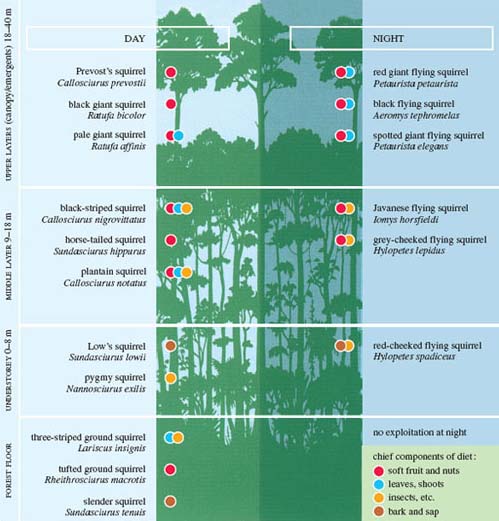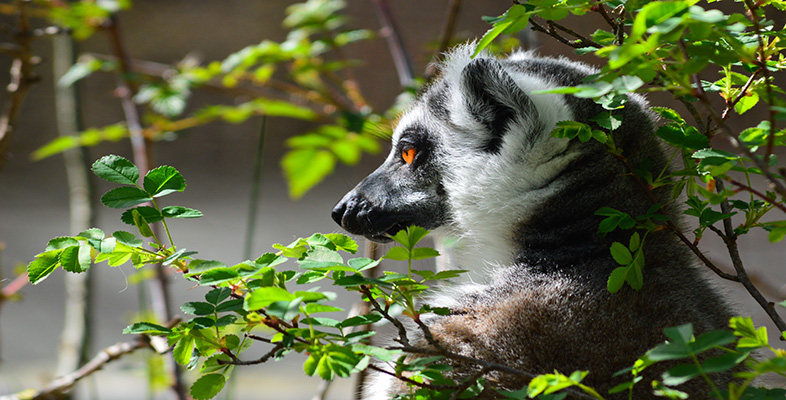2.5 Tree squirrels
Coevolution also underpins the relationship between many tree squirrels and the trees that house them. The creation of food caches as a 'winter-larder' is mutually beneficial, partly because squirrels are sufficiently profligate in their habits to ensure that many stores are overlooked. Stealing by neighbours is so common that such over-provision may be essential - it's not through forgetfulness or lack of skill; grey squirrels appear able to detect nuts buried as deep as 30 cm below the surface. As you know, seeds that remain buried are often well placed to germinate. But neglecting some caches is a viable tactic only if an abundant crop of seeds is produced. The sacrifice of a modest number of seeds to satisfy the squirrel's habits is seemingly a cost worth paying.
But this cosy mutuality is not guaranteed. The tassel-eared squirrel, for example, depends on the Ponderosa pine for food and shelter. Oddly, this species has never acquired (or has lost over evolutionary time) the habit of cache-making. Neither does it undergo winter hibernation - though remaining active throughout the year is far from unusual amongst squirrels. In the winter months, this squirrel exists almost exclusively on a diet of the inner lining of the bark (the phloem layer), which is an essential component of the tree's transport system; the resulting damage to the tree is significant. The benefits from this tight relationship are seemingly very one-sided.
Tropical tree squirrels provide an excellent example of niche separation. Different species don't mill around indiscriminately in any one area of the tropical rainforest; rather, they have distinct lifestyles and preferences for particular foodstuffs. The background of tree outlines in (below) shows the various layers of tropical rainforest - for the moment, ignore the placement of the different species of tree squirrel. The trees comprising the canopy grow up to 40 m in height, their growth producing a continuous and dense mass of overlapping branches, leaves, flowers and fruit. Some taller trees (emergents) can burst through the canopy. In the middle layer, the trees are somewhat shorter and the vegetation less dense. The understory comprises small and young trees, while the forest floor is a dark area of shrubs and ferns, plus a layer of leaf litter, which is subject to rapid breakdown and utilisation via the action of decomposers and scavangers.

Question 5
Question: Which layer in Figure 1 is likely to be subject to very changeable physical conditions and to receive the greatest sunshine and heaviest rainfall?
Answer
The uppermost canopy layer, i.e. the crowns of the tallest trees, plus the growth that rises up through it - the emergent layer.
Question 6
Question: Look at the location of the middle layer. What conditions are likely to prevail here, with respect to temperature, air movement and rainfall?
Answer
This layer is more protected from sunshine and is generally more stable. For much the same reason, there is relatively little air movement. Rain from the canopy eventually drips downwards and the still air can readily become saturated with moisture.
In one particular Malaysian forest location, 25 species of tree squirrels have been identified, 11 nocturnal and 14 active by day (i.e. diurnal). (Relatively few Malaysian squirrels are seed eaters, compared to their African or temperate forest counterparts.)
Activity 4a
Study the information in Figure 1 showing where many of these tree squirrels feed and their food preference.
(a) Does any one species feed during both the day and the night?
Answer
No; as you'd expect these species are either diurnal or nocturnal, i.e. there is separation between these species in time. (Note that the flying squirrels are all nocturnal.)
Activity 4b
(b) Does any species feed in more than one part of the forest?
Answer
No, each species seems to be restricted to a particular forest layer. Flying squirrels tend to feed in particular locations - for example, the upper or middle layers - which means there is separation between these species in space.
Activity 4c
(c) Do the species that inhabit the same part of the forest profile generally eat different foodstuffs?
Answer
Sometimes diets are distinct and the species non-competitive - as in the three diurnal species feeding on the forest floor. But there is some overlap; for example, look at the three diurnal species feeding in the upper layers.
Activity 4d
(d) What conclusions can you draw from the information in Figure 1? Write an answer of about 50 words.
Answer
The forest provides a variety of resources available for exploitation - e.g. insects, fruit, leaves and bark - located in different parts of the profile. Differences in the lifestyles and feeding preferences of tree squirrels reflect their occupation of particular niches, and may reduce, though not eliminate, competition between species for these available resources.
This is an example of niche separation, which in this instance may be even more marked than Figure 1 alone suggests. The three diurnal squirrels identified in the upper layers have subtly different fruit preferences and feeding strategies. For example, Prevost's squirrel has a narrower range of preferred fruit, and its smaller size and greater agility enable it to reach foods inaccessible to the black giant squirrel. But niche separation works best when foodstuffs are relatively plentiful. With these Malaysian tree squirrels, nearly all species consume bark and sap when other foodstuffs are less freely available, at which point direct competition between species is more prevalent.
Activity 5
As a conclusion to what you have read in this course period so far, give a brief account, in about 150 words of the consequences of the tree-dwelling habit for mammals, with examples. Refer in your answer to the key concepts of the influence of predators, sensory communication, coevolution and niche separation.
Answer
Tree-dwelling mammals may escape terrestrial predators but they are exposed to others, notably birds of prey. Many tree dwellers are nocturnal and there are advantages for some (e.g. flying foxes) in congregating in large numbers, which may have the advantage of decreasing the risks of predation to any one individual. Since visibility in trees may be limited, communication by smell can be important (e.g. in the kinkajou), though judging distance requires visual acuity. A reciprocal influence on evolution is evident in the intimate relationship between some arboreal species and the trees that sustain them, e.g. pollination by flying foxes reveals coevolution. Tree dwellers are unlikely to feed indiscriminately; rather there is niche separation. Different tree squirrels that occupy the same part of the forest may have different food preferences. Available niches within a forest area are likely to be utilised by specialist feeders.
